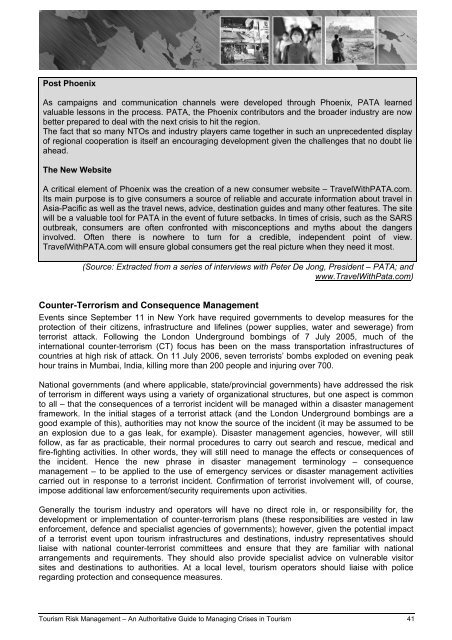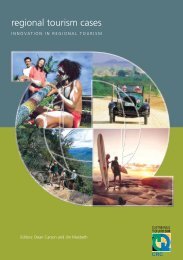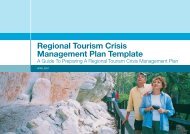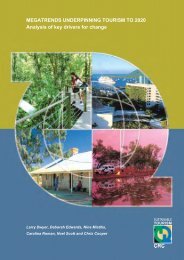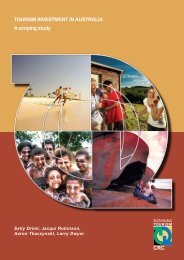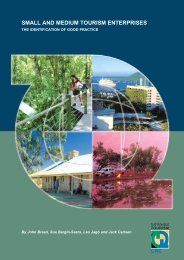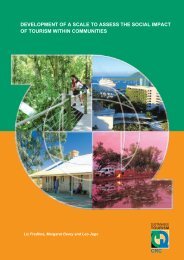Tourism Risk Management - Sustainable Tourism Online
Tourism Risk Management - Sustainable Tourism Online
Tourism Risk Management - Sustainable Tourism Online
Create successful ePaper yourself
Turn your PDF publications into a flip-book with our unique Google optimized e-Paper software.
Post Phoenix<br />
As campaigns and communication channels were developed through Phoenix, PATA learned<br />
valuable lessons in the process. PATA, the Phoenix contributors and the broader industry are now<br />
better prepared to deal with the next crisis to hit the region.<br />
The fact that so many NTOs and industry players came together in such an unprecedented display<br />
of regional cooperation is itself an encouraging development given the challenges that no doubt lie<br />
ahead.<br />
The New Website<br />
A critical element of Phoenix was the creation of a new consumer website – TravelWithPATA.com.<br />
Its main purpose is to give consumers a source of reliable and accurate information about travel in<br />
Asia-Pacific as well as the travel news, advice, destination guides and many other features. The site<br />
will be a valuable tool for PATA in the event of future setbacks. In times of crisis, such as the SARS<br />
outbreak, consumers are often confronted with misconceptions and myths about the dangers<br />
involved. Often there is nowhere to turn for a credible, independent point of view.<br />
TravelWithPATA.com will ensure global consumers get the real picture when they need it most.<br />
(Source: Extracted from a series of interviews with Peter De Jong, President – PATA; and<br />
www.TravelWithPata.com)<br />
Counter-Terrorism and Consequence <strong>Management</strong><br />
Events since September 11 in New York have required governments to develop measures for the<br />
protection of their citizens, infrastructure and lifelines (power supplies, water and sewerage) from<br />
terrorist attack. Following the London Underground bombings of 7 July 2005, much of the<br />
international counter-terrorism (CT) focus has been on the mass transportation infrastructures of<br />
countries at high risk of attack. On 11 July 2006, seven terrorists’ bombs exploded on evening peak<br />
hour trains in Mumbai, India, killing more than 200 people and injuring over 700.<br />
National governments (and where applicable, state/provincial governments) have addressed the risk<br />
of terrorism in different ways using a variety of organizational structures, but one aspect is common<br />
to all – that the consequences of a terrorist incident will be managed within a disaster management<br />
framework. In the initial stages of a terrorist attack (and the London Underground bombings are a<br />
good example of this), authorities may not know the source of the incident (it may be assumed to be<br />
an explosion due to a gas leak, for example). Disaster management agencies, however, will still<br />
follow, as far as practicable, their normal procedures to carry out search and rescue, medical and<br />
fire-fighting activities. In other words, they will still need to manage the effects or consequences of<br />
the incident. Hence the new phrase in disaster management terminology – consequence<br />
management – to be applied to the use of emergency services or disaster management activities<br />
carried out in response to a terrorist incident. Confirmation of terrorist involvement will, of course,<br />
impose additional law enforcement/security requirements upon activities.<br />
Generally the tourism industry and operators will have no direct role in, or responsibility for, the<br />
development or implementation of counter-terrorism plans (these responsibilities are vested in law<br />
enforcement, defence and specialist agencies of governments); however, given the potential impact<br />
of a terrorist event upon tourism infrastructures and destinations, industry representatives should<br />
liaise with national counter-terrorist committees and ensure that they are familiar with national<br />
arrangements and requirements. They should also provide specialist advice on vulnerable visitor<br />
sites and destinations to authorities. At a local level, tourism operators should liaise with police<br />
regarding protection and consequence measures.<br />
<strong>Tourism</strong> <strong>Risk</strong> <strong>Management</strong> – An Authoritative Guide to Managing Crises in <strong>Tourism</strong> 41


